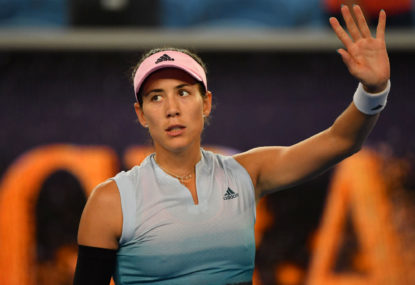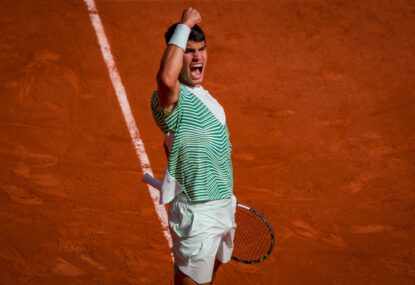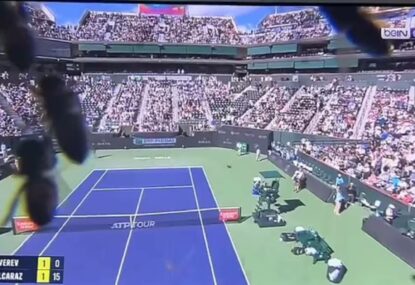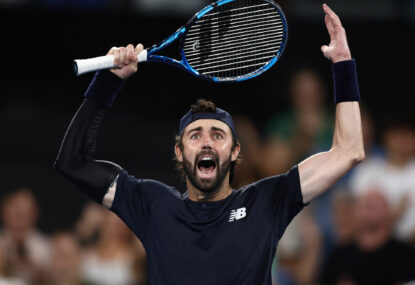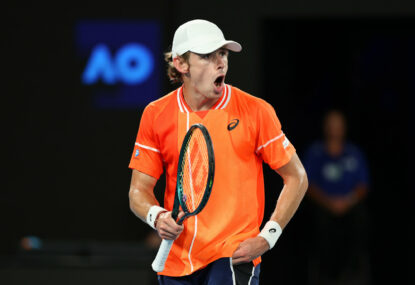The Australian Open is well underway and Australian legend Pat Cash has revealed he has pushed for a faster court surface at the Melbourne Park event for the past few years.
So now is the time to delve deeper into a relatively unspoken change in tennis – the slowing down of court surfaces around the world.
Over the past decade, tinkering with court surfaces has drastically transformed the game of tennis. The cause of this transformation is the convergence of the four different court types.
15 years ago, each of the four different court types were extremely different, slow hard court, clay, grass and fast hard court, and it was extremely difficult for one player to dominate on all four courts, if not impossible.
It would be far too boring to go in detail into the history of court surfaces, so I’m not going to do that. But I will say this, in the late 90s, tennis was widely lauded as boring, fans were turning away from the big serving, three point rallies which were present in matches played on the US Hard courts and Wimbledon lawn, typified by big servers Pete Sampras and Goran Ivanisevic.
To counter this, a number of strategies have been implemented, the most notable, yet least talked about, was the tinkering with courts.
The already slow hard courts of the Australian Open were slowed even more when it moved to Plexicushion in 2008, the French Open clay courts have been and always will be slow, Wimbledon switched to an all-rye formula in 2001 which has significantly slowed down the courts as the years have progressed and even the US Open has made some court changes, adding more sand to the acrylic paint mix to slow down the court.
The tinkering with courts has had a significant and not necessarily positive effect on the game. It has enabled the same four players to dominate the sport year round, something unprecedented.
It is highly unlikely Rafael Nadal would have won as many Wimbledons and US Opens as he has if he was playing tennis in the late 90s, because his game wasn’t suited to the fast courts that used to be present.
Tennis players had to adapt to the conditions, today the three non-clay, ‘quicker’ Grand Slams more closely resemble the French Open more than ever before, allowing players to adopt the same game plan – a defensive slugfest.
One player who has been significantly disadvantaged by the tinkering with courts is Roger Federer. The slowing down of courts has enabled his biggest rivals, Nadal, and to a lesser extent, Novak Djokovic to challenge him on all four court types.
The slowing down of the courts has enabled Nadal and Djokovic to play five-hour baseline slugfests, with the players running from side to side and playing very defensively.
This is not Federer’s style of play and the slow courts have made it more difficult for Federer to put his opponents away at the end of points.
Whether the slowing down of courts is good for tennis or not, there is no doubt it has not been beneficial to Federer, making it more difficult to win Grand Slams.
As I stated above, many fans found the late 90s style of play boring, in fact Rafael Nadal has openly criticised the tennis played in that era, labelling it “not enjoyable” and “not really tennis”.
Nadal again was critical of quicker courts in his post match press conference at the Australian open following his first round victory over Bernard Tomic, saying “the great ones for the crowd are much more difficult”.
It comes as no surprise Nadal is critical of faster courts, they don’t suit him and if courts were to suddenly quicken up, Nadal would struggle significantly, it’s in his best interest that courts remain slow.
But now things are starting to come full circle. Fans are tiring of the same two or three players winning every Grand Slam of the year and they are tiring of the baseline slugfests played between today’s greats.
Fans are beginning to label the current era of tennis boring, and many are longing for the enterprising serve and volley style of play used by greats of past decades, such as Australian hero Pat Rafter.
This is why the buzz around Rafter’s return to play in the doubles at the Australian Open was so big; fans love his style of play, a style which is scarcely seen on the men’s professional circuit in recent times.
The serve and volley style of play is just not feasible, it’s far too risky to regularly come into the net. If your approach shot is not perfect, you face a shot ripping past you.
There have been growing concerns in recent times about the rising toll of injuries being suffered by professional tennis players, the most high profile being Rafael Nadal and his injured knees.
There are a number of reasons to be blamed for the increase in injuries, including a shortened offseason, increase in the number of tournaments and the widespread use of hard courts.
The vast majority of tennis tournaments being played around the world are now played on hard courts. A smaller number are played on clay and even fewer are played on grass.
Hard courts are effectively concrete, extremely unforgiving on the body’s joints, especially the knees and ankles.
And guess what else has come along with an increase in the number of hard court tournaments? That’s right, the slowing down of hard courts.
So not only are players playing more tennis on hard courts, but their matches on hard courts are going for longer.
Today’s style of play means players, such as Nadal, are able to keep playing until their body literally fails them, as Nadal’s has.
It’s obvious why tournaments are played on hard courts and not clay or grass, it’s far cheaper and easier to maintain, but it’s also harder on the players. This is why many ex-players are calling for a reduction on the matches being played on hard courts and an increase in the number of tournaments being played on grass.
This will reduce the impact on the players’ joints which is present on hard courts, but it does not solve the issue of the length of matches. To solve this, the courts must be quickened up again.
One solution would be to dump the 100% rye formula and return to the 70% rye–30% creeping red fescue grass mix, another is replicating the Australian Open and changing the balls to make them less fuzzy.
Further highlighting how far this debate has come over the past two years is Tennis Australia’s reaction to Pat Cash’s requests for a quicker court surface.
In 2012, after a six-hour epic baseline slugfest in the men’s final between Djokovic and Nadal, Tennis Australia officials looked at Cash as if he was from Mars, after he suggested the courts must be quickened up in order to keep the sport fairer.
But now, just two years later Tennis Australia officials have heeded Cash’s advice and made the courts less abrasive and changed the tennis balls used.
Previously, the court fluffed the balls up very quickly, making them bigger and heavier, slowing them down. This year the tennis balls fluff much slower and the court fluffs them less.
Cash argues this makes the game of tennis much fairer and gives all styles of play an opportunity to win the tournament, not just the back-court players, and it brings back the serve-volley style of play to the sport.
The slowing down of court surfaces has drastically changed the game of tennis in the past decade. It has enabled the back-court players to dominate the sport and allowed four men to win all year round.
Many of the tennis-watching public, the fans who watch eight weeks of tennis a year, would have very little knowledge of court surfaces and their impact on a match. This is starting to change and the fans are now demanding that an attacking style of play is rewarded and not punished by the courts.
The Australian Open has taken the lead by quickening up the speed of its surface, now it’s time for Wimbledon and the US Open to follow suit.































































































